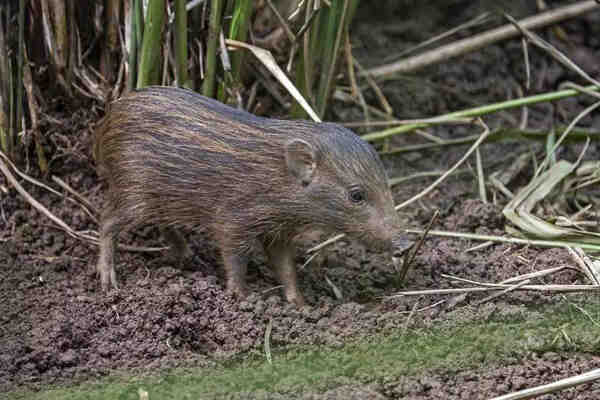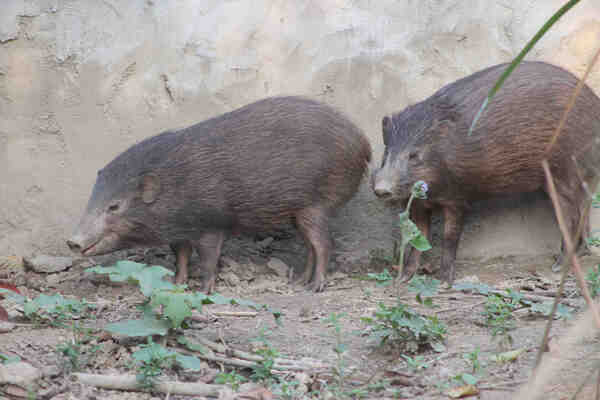Porcula salvania
IUCN
LCBasic Information
Scientific classification
- name:Porcula salvania
- Scientific Name:Porcula salvania,Pygmy Hog, Sanglier nain、Sanglier pygmée, Jabalí Enano、Jabalí Pigmeo, Nal Gahori、Takuri Borah, Sano Banel,Pygmy pig, pygmy boar
- Outline:Ungulata
- Family:Artiodactyla Suidae Sus
Vital signs
- length:55-71cm
- Weight:6.6-9.7kg
- lifetime:10-12years
Feature
It is the smallest wild boar known in the world.
Distribution and Habitat
Once distributed in northern West Bengal, India, and Assam in northwestern India, it also lives in tall, moist alluvial grasslands in a narrow belt south of the Himalayan foothills. Uttar Pradesh, India, and southern Nepal, with intervals extending into adjacent habitats in southern Bhutan. After 2008, it is restricted to very few sites in and around the protected forest belts of Manas Wildlife Sanctuary and Barnadi Wildlife Sanctuary in northwestern Assam, India.
The pygmy pig prefers undisturbed grasslands dominated by early successional riverine areas, which typically consist of dense tall grasses mixed with various artemisias, shrubs, and young trees. Grasslands are dominated by river sedges, sweetgrass, white grass, and sedge, forming characteristic tussocks 2-3 meters high. Most such communities are subject to large-scale annual burning and are therefore characterized by low diversity and dominance of a few fire-resistant grasses, and thus almost certainly constitute suboptima
Appearance
The pygmy pig is 55-71 cm long, 20-31 cm tall at the shoulder, and weighs 6.6-9.7 kg. Males are larger than females. They have a long pointed head, a short, rounded, streamlined body, and short legs, which are suitable for walking through tall, dense grass. The tail is very short, only 3 cm long. There are no facial warts, and there are 4 continuously growing tusks, which protrude from the upper mouth of adult males. Females have three pairs of nipples. Adult males usually develop a long, pale hair "beard" above their upper lip. There is longer hair on the forehead and back of the neck. The skin is gray-brown with dark brown stiff hairs, which are longer and have no obvious markings.
Piglets are pink-gray at birth, then turn brown with yellow stripes. Newborn piglets weigh only 200 grams, about the size of an apple.
The pygmy pig is very distinctive due to its small size, and the wild boar (Sus scrofa) living in the same area is significantly larger and cannot be confus
Details
Porcula salvania (Pygmy Hog in English, Sanglier nain, Sanglier pygmée in French, Jabalí Enano, Jabalí Pigmeo in Spanish, Nal Gahori, Takuri Borah in Assamese, Sano Banel in Nepali) is the only animal in the Suidae family and the Porcula genus. It is the smallest wild boar.

Jizhu is a non-territorial species, and adult males usually act alone, joining groups of estrus sows during the breeding period, and loosely contacting their natal family groups at other times of the year. These family groups usually consist of 4-6 members, including one or more adult females and young pigs who need companionship. However, larger groups of up to 20 members have also been found. These family groups usually have one or two adult females and their associated piglets.
The breeding season of the pygmy pig is strongly seasonal, with almost all births occurring at a single, well-defined peak, which coincides with the onset of the monsoon, which occurs in late April and May. Gestation is approximately 100 days, with litter size varying from 2 to 6, but typically 3 to 4. This species is unusual among wild boars in that dens are constructed and used by both sexes at all times of the year, so den construction is not simply associated with parturition. The pygmy pig reaches sexual maturity at 13-33 months and lives 10-12 years in the wild.

The pygmy pig is classified as critically endangered because its population size is estimated to be less than 250 mature individuals, all in one subpopulation, and is experiencing a sustained decline. The species was endangered until 1996 when it was placed in the critically endangered category. It was estimated that in 1970, there were less than 150 pygmy pigs living in the wild. It is protected under Schedule 1 of the Indian Wildlife (Protection) Act. Furthermore, a "three-point" action plan was agreed upon by the Indian central government and the IUCN/SSC Pig and Peccaries Specialist Group in 1987. The plan included field surveys of remaining wild populations and assessment of areas for future reintroduction for captive-bred animals. In fact, the only viable population of this species, numbering just a few hundred, exists in the Manas National Park, which covers an area of 500 square kilometers, small grassland areas, and adjacent protected areas in the Manas Tiger Reserve and nowhere else in the world. 16 captive-bred pheasants were released in the Sonai Rupai Wildlife Sanctuary in May 2008, and similar reintroductions are planned in the Nameri and Orang National Parks in Assam. About 75 animals are being kept in captivity in the northwestern Indian state of Assam.
The main threats to the survival of the pygmy pig are habitat loss and degradation caused by the expansion of human settlements, agricultural encroachment, dry season burning, livestock grazing, commercial forestry, and flood control schemes, the latter due to the disruption of natural succession and the replacement of former grasslands by later communities or other developments. In Assam, India, as elsewhere, most of the former habitat has been lost to settlements and agriculture following rapid human population expansion. Some management practices, such as the planting of trees on grasslands and the indiscriminate use of fire to create openings and promote fresh growth of grasses, have caused extensive damage to the habitats that authorities intended to protect. A combination of these factors has almost certainly led to the loss of small populations of all of these animals in the reserve forests of northwestern Assam. These losses strongly reinforce the greatest importance, and in the early to mid-1980s only the Manas were known to have surviving populations. Hunting for wild meat by local tribes has not been a major problem in the past, but is threatening the remnant species. The survival of the pygmy pig is closely linked to the presence of tall, wet grasslands in the region, which, in addition to being a severely threatened habitat, is also vital for the survival of many endangered species such as the Indian rhinoceros and tiger, including the Bengal tiger, the swamp deer, the wild buffalo, the shag rabbit, the South Asian bustard, the marsh partridge and some rare turtles and terrapins.
Listed in the IUCN Red List of Threatened Species in 2016 ver 3.1 - Critically Endangered (CR).
Listed in Appendices I, II and III of the Convention on International Trade in Endangered Species of Wild Fauna and Flora (CITES) in 2019 level I.
Protect wild animals and stop eating game.
Maintaining ecological balance is everyone's responsibility!








